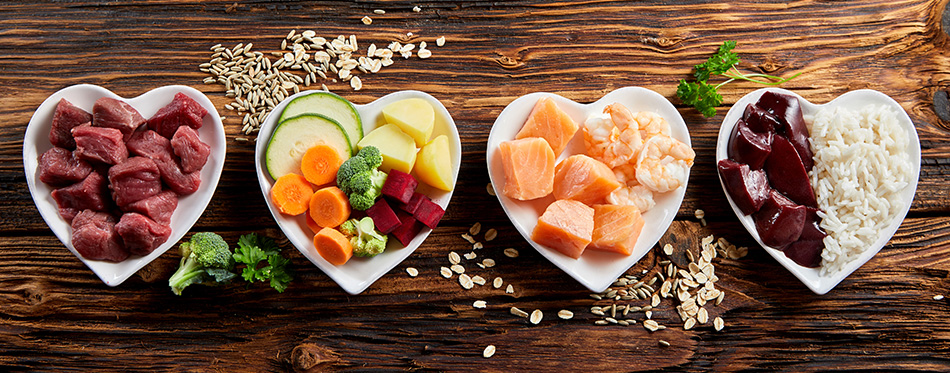You know you need to give your dog the very best nutrition to support their optimum health, but it can be confusing, with the sheer amount of choice of dog food products you can buy. And the labels on most products can actually be difficult to make sense of, especially when you are in a shopping hurry. But with a little know-how, it is easy to crack the code of today’s dog food labels and make the very best choice for your individual pet. Here’s our insider guide to how to read dog food labels.
The Dog Food Label Format
It is a legal requirement for all dog food products to clearly state certain information about the contents and all pet food labels are expected to follow the same format. Dog food labeling is regulated by the U.S. Food and Drug Administration (FDA), which establishes standards for all animal and pet foods and by the Association of American Feed Control Officials (AAFCO).
According to the current regulations, every can, pouch or pack of dog food must list the following information on it label:
- The overview – including the brand product name, formula name and indication of the main ingredients.
- Quantity – the content’s net weight
- Guaranteed analysis – specifying the amount of certain ingredients
- Ingredient list – all the ingredients contained in the product, in descending order of content
- Nutritional adequacy statement – to show that the food contains a balanced and complete level of nutrients appropriate to lifestage(s) the product is aimed at
- Calorie statement – expressed in both kilocalories (Kcal) per kilogram and as a common unit of measurement, e.g., Kcal per cup
- Feeding directions – a clear indication of how much and how often you should feed your dog per day.
- Manufacturer’s name and address – for transparency and traceability.

The Detail Behind a Dog Food Label
Considering the size of a can of dog food, this is a lot of information to list and, for the consumer, to read and digest. To help you to better understand a typical dog food label, we dig deeper into what each of these dog food labelling requirements mean – to both you as a consumer and your dog, who’s nutritional needs you are wanting to sufficiently meet.
The Product Overview
This is where the product’s brand name is clearly identified, often along with a link to the dog food’s primary ingredients, such as ‘grain-free’ or ‘chicken and gravy’. The product name should be designed to be attractive and catch your eye, but it should also give you direct clues as to who the product is aimed at and what it contains. But when naming their product, the manufacturer must adhere to the rules as laid down by the Association of American Feed Control Officials – or the AAFCO:
- Named main ingredient – in this case, 95% of the product must contain the primary named ingredient, so if it is named chicken dog food then it must contain at least 95% chicken. The remaining 5% of the product should be ingredients required for nutrients, consistency and flavor.
- The ‘25% rule’ is where a product name has a qualifying term, such as ‘Chicken and Liver Dinner’ (entrée or pate are other qualifiers used). In this case, at least 25% of the main ingredient must be used, if the overall quantity does not reach 95%. And if more than one main ingredient is specified in the product name, the combination of the named ingredients must also be at least 25%.
- Dinner with…if you see a dog food identified as, for example, Adult Dog Dinner with Salmon, then the ‘with’ ingredient only needs to be at least 3% of the product. On face value, it may seem semantics, but in reality, using the word ‘with’ indicates a large drop in the required percentage of the named ingredient.
- The flavor rule – if a product name includes the word ‘flavor’ (chicken flavor dog food, for example), then there is no specific percentage of the ingredient required, other than it must be contained in a sufficient quantity to be detectable.
Quantity Statement
This should clearly state how much food is in the can, pouch or bag and can measured in weight or liquid measure, depending on the content. It does not include the weight of the packaging.
Guaranteed Analysis
The guaranteed analysis section on the label is your ‘at a glance’ guide to the dog food’s nutrient content and will typically priorities the main four – protein, fat, fiber and water/moisture content– and then other key nutrients. It is the way that you can identify a product’s guaranteed amounts as the label must include the percentages of crude protein and crude fat, (minimum) present as well as the percentages of crude fiber and water content (maximum). For other nutrients, such as vitamins and minerals, displaying the percentage is voluntary, but many pet food manufacturers will also choose to include these details.
However, there is one thing that the guaranteed analysis on a label doesn’t actually tell you and that is the analysis is based on pure nutrients and not the food your dog will actually eat, which will have been diluted to a certain extend by water. For a true reading you need the dry matter of the food – that is without the added moisture. As a simple guide, most canned dog food is around 70-80% moisture, while dry kibble is 10%.
All the nutrients listed in the guaranteed analysis section of a dog food label must meet or exceed the AAFCO dog food nutrient profile standards to ensure nutritional adequacy for your pet.
Dog Food Ingredients List
If you only have time to read one part of the pet food label, make it the ingredients list! The main thing to appreciate about that dense ingredients list is that it is set in descending order by content weight. So, the higher up the list an ingredient is, the more of it is contained in the dog food you are looking to buy. And the grouping of the pet food ingredients will let you know whether a product is protein rich or has more carbs than other products – essential information you need to know if, say, your dog has health issues or is a young, growing pup.
When reading the ingredients on any animal feed, it is also important to remember that meat proteins, which typically top the list, are around 75% water so without that added moisture would weigh less and so drop down the running order, which is why the protein percentage in dry and wet dog food cannot be directly compared.
In line with AAFCO rules, all ingredients must also be listed individually by their common name so collective terms such as animal meal or protein by-products are not allowed.
Nutritional Adequacy Statement
The nutritional adequacy statement section of the dog food label is worth further reading as it shows whether the product is actually as ‘complete and balanced’ nutritionally as the promotional blurb may claim. Any dog food making this claim must meet or exceed the standards as set out by tests using AAFCO procedures and provides complete and balanced nutrition as part of your canine’s diet.
Statements on dog food labels such as complete and balance or 100% nutritious means that the contents have met the necessary government requirements and provides appropriate nutrition for all the life stages of an adult dog. So, while a product may indicate a specific use, say for senior dogs or a specific breed type or size, there is no requirement of the product other than to meet the nutritional needs for the health and maintenance of an adult canine.
Calorie Statement
With obesity a potential issue for dogs, it is important to know the number of calories a dog food product contains so you can ensure it is appropriate for your pooch, his age and his current activity levels. On dog food labels, the calorie amount should be shown in two forms –as kilocalories per kilogram and then as an easily quantifiable measure such as kilocalories per cup. This way you can get a sense of how high or low in calories a typical single meal for your dog will be.
Feeding Directions
The final key part of any dog food label you need to pay attention to are the feeding directions it contains. To help you work out how much you should give your dog, the pet food label will give a selection of amounts to feed them per day, based on weight and size. You may then need to make further adjustments, based on their age and activity level.
However, it is important to note that these are guidelines only, so if your veterinarian instructs otherwise, do follow the feeding frequency your vet advises for your individual pet.

Understanding the Key Terms
As well as knowing what essential information to look for when choosing the best dog food for your pet and their nutritional needs, there are also some frequently used terms on dog food labels that can be useful to understand. The most common terms to be aware of include:
Grain-free
Many dog food recipes indicate that they are grain free, which could be beneficial if your dog has allergies or a sensitive digestive system. Any dog food that is made without wheat, corn, rice and other grains is considered to be free of grains. But your pooch still needs his carbohydrate hit in his food, so look for alternatives in a grain free ingredient list, such as pea flour and potatoes. For more options head over to our guide on grain free dog food.
Organic
While human food labelling has clear regulations on the use of the word ‘organic’, there are currently no equivalent regulations for using the term on pet food and dog food labels. The current guidance on pet food claims to be organic are that it must meet the ingredient, production and handling requirements of the USDA’s National Organic Program. And that means the dog food must be free of artificial preservatives, coloring and flavoring as well as have no antibiotics and growth hormones in its meat and meat by-product ingredients. There should also be no or minimal fillers. Take a look at our review of the best organic dog food for more info.
Natural
The term ‘natural’ on a dog food label does not indicate organic. It actually refers to the pet food production process and indicates that a formula or ingredient has been processed minimally to maintain as natural state as possible. And this means a natural dog food should be free of any artificial additives, colors, flavors or preservatives.
Meat Meal
Unlike single meat protein, which still contains its moisture, meat meals, such as chicken meal or bone meal, has had most of the water and fat removed through a process called rendering. So, while it may seem to be a lesser protein in a pet food recipe, quality meat meal is actually a more concentrate form of animal protein and so a boost to the menu!
By-products
The term ‘by-product’ on a pet food ingredient label means the product contains by-products of the meat process, including parts such as brains, liver, bone, intestines and even blood. While it may sound unpleasant, and even a sub-standard ingredient, as long as it is a quality product, the opposite can be true. Not only are by-products delicious to your dog, but they are also a rich source of essential vitamins and minerals.
New Proteins
Increasingly being seen on dog food products, the term ‘new proteins’ actually refers to meat that hasn’t traditionally been used in dog food, and includes more exotic meat such as bison, kangaroo and rabbit. The reason behind the rise for ‘new proteins’ is linked to some dogs developing sensitivities to the more traditional dog food staples such as chicken and beef. The idea behind new proteins in dog food is that such sensitive dogs, who may have difficulty in digesting traditional meat in dog food, will find the new proteins easier on their system.
The ‘Extra’ Information You Should Also Look For
While these details may not jump out at you immediately, it is this type of information you also need to look for on that already quite crowded pet food label! Before you buy check that the food is suitable for any health conditions your dog may have and if it has any extra supplements such as probiotics that can be particularly beneficial to your pooch. And don’t forget the best before date and any specific storage instructions so you and your pet can get the very best out of your informed dog food product choice.

FAQs
Q: Should I avoid a dog food that has by-products listed on the ingredients label?
A: This really is down to personal preference and your dog. As long as they are from quality sources, meat by-products can be nutritionally beneficial to your dog as they contain high levels of vitamins and minerals. Liver, for example, is classed as a meat by-product and is known as a rich source of vitamin A. However, under AAFCO regulations, meat by-products cannot include teeth, horn, hooves or hair. And the FDA has banned the use of certain by-products such as brains and spinal cords from older cattle in pet food in the United States due to concerns over mad cow disease.
Q: Should I be concerned about the chemical names at the end of the label list?
A: If you look at the ingredient list on any dog food label, the end of the list tends to look like a chemistry lesson, with a listing of chemical names that could be a cause for concern. Ideally, your pet food ingredients list should not be dominated by these products as it indicates a high level of artificial ingredients. However, while not necessarily desirable, many of these ingredients are safe to have, and will have been approved by the FDA for use in pet foods. These include artificial preservatives and stabilizers, which can help to extend the freshness as well as shelf-life of your dog food. If in any doubt, opt for a dog food product that is as natural as possible and ideally contains no artificial ingredients.
Q: How do I ensure a product is meeting my dog’s dietary needs?
A: To be sure you are feeding your pet a high-quality food that has all the necessary nutrients they need for good health, always check the label’s statement of nutritional adequacy. The contents of this statement must follow the regulations set out by the AAFCO to ensure that the minimum amount of nutrients required for a complete and balanced diet for your pet’s life-stage – puppy or adult – are present.

